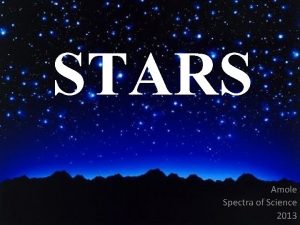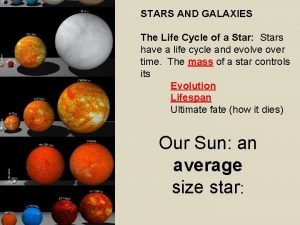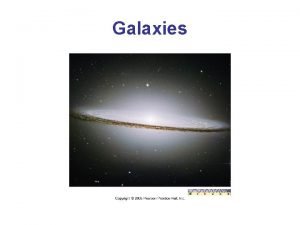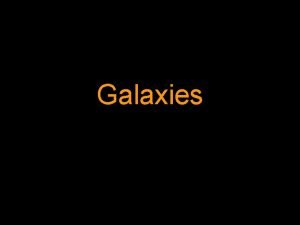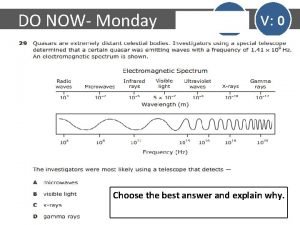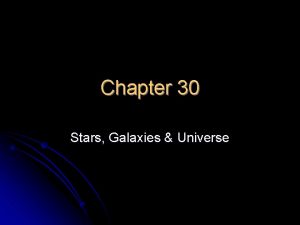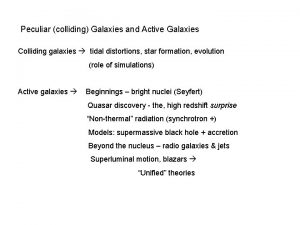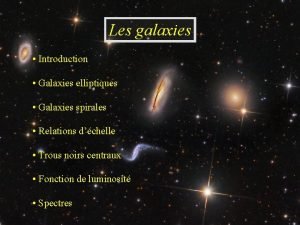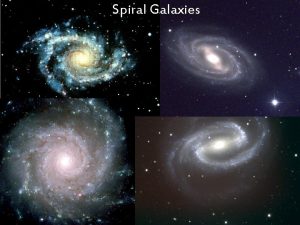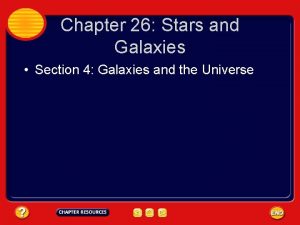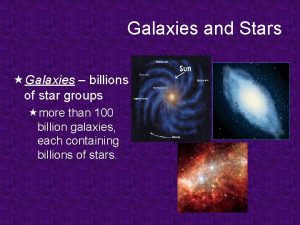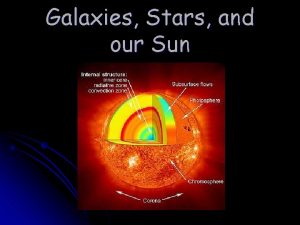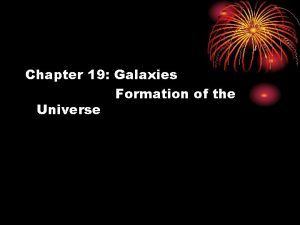Stars Galaxies and the Universe Mr Foxs Science


































- Slides: 34

Stars, Galaxies, and the Universe Mr. Fox’s Science Class

The Basics • Galaxy – a grouping of hundreds of billions of stars. • Universe – billions of galaxies make up the entire… well… everything (to what we believe) • Light-year – the distance light travels in one year. 9. 5 million kilometers.

Classifying Stars • Main characteristics for stars size, temperature, and brightness. • Size – straight forward. Giant stars, or supergiant stars. – Betelgeuse – would fill up the solar system to Jupiter. • Temperatures – 3, 200 Celsius reddish color, 5, 500 Celsius white in color 10, 000 Celsius blue-white color

Classifying Stars • Brightness – the amount of light they give off • Apparent magnitude – brightness as seen from Earth. • Absolute magnitude – as seen if it were a standard distance from Earth. (blah where is the cool stuff Mr. Fox)


Star Life • (here we go) • Protostar – When contracting gases get so HOT that nuclear fusion starts to happen. • How long it lives depends on mass – Our star is a medium sized star, and it has been around 5 billion years, and still have 5 billion years left. • Stars are born in nebula, a giant cloud of gas and dust in space.


Star Death • When the star runs out of fuel, it will become one of three things. . – White Dwarf – a small blue-white hot core of a star that eventually burns out and becomes a black dwarf (which doesn’t give off light and is dead). As small as Earth. – Neutron Star – smaller and denser than a white dwarf. As small as a town on earth. – Black Hole – Gravity is so strong, because there is so much mass, that light cannot escape!


Black Holes • Simplified – they are caused when supergiant stars explode or supernova. • They suck in EVERYTHING that is near them, light, radio waves, matter… doesn’t matter. • Detected via X-rays in space from the gases being sucked into them. • Little is known about them, but much is theorized about them. • We believe there is a black hole that holds our galaxy and every other galaxy together.


Pulsars and Quasars • Pulsar – neutron star that produces pulses of radio waves. – In the 1960 s, they thought these radio waves were from extraterrestrial civilizations. • Quasars – objects that are 12 billion light-years away that looked like stars. – They are thought to be old galaxies. An extremely massive black hole surrounded by a halo of mass.


Home Work • Page 116 1 – 5 • Quiz on the Planets and Stars on Friday.

Some Facts • The more mass a star has the shorter the life. • The Sun, will become a red giant, before becoming a White Dwarf. Of the front 4 planets, only Mars will survive. • A young galaxy is called a Dwarf Galaxy.

Galaxy • There are billions of Galaxies out there, that all have differences to them • There are three main types of galaxies – Spiral Galaxies – Elliptical – Irregular

Classes of Galaxy

The Milky Way Galaxy • This is the Galaxy our solar system is in. • Our sun is about 30, 000 light years from the center of our galaxy. • It is estimated that our galaxy is 100, 000 light years wide. • Our Galaxy is a Spiral Galaxy

Milky Way Galaxy

Spiral Galaxy • A galaxy who’s arms spiral outward looking like a pinwheel or a buzz saw. • Andromeda is the closest galaxy to us, and it is also a spiral. PS: this galaxy is on a crash course with us…. . (more on this later)

Andromeda Galaxy

Other Spiral Galaxies Pinwheel Galaxy M 51

Elliptical Galaxy • A galaxy shaped like a flattened ball that only has old stars.

Elliptical Galaxies Galaxy M 87 with it’s Jet Galaxy M 32

Irregular Galaxy • A galaxy that doesn’t have a normal shape.

Examples Hoag’s Object (Ring Galaxy) Centaurus A

More Examples The Cart Wheel Galaxy (and some others there )

The Sombrero Galaxy (Ring Galaxy)

Galaxy Clusters • Sometimes Galaxies get close to each other and form a cluster. • They end up sharing some sort of gravitational point. • The Milky Way is in a cluster with 11 other Dwarf Galaxies • Dwarf Galaxy – a smaller galaxy that is a satellite of a larger galaxy. Sometimes they are what’s left when two galaxies collide.

Galaxies Move • The sun revolves around the center of the Milky Way. It takes 250 million years!!!! For it to make one revolution around it. • Galaxies were also discovered to move around in space. • 1920 s: Edwin Hubble discovered that the galaxies are moving within space. He saw that further a galaxy was from us, the faster it was moving away from us.

Galaxies Move • Galaxies can and will crash into each other. (WMP Video Here)


Collided Galaxies Antenna Galaxy

Collided Galaxies
 Chapter 30 galaxies and the universe
Chapter 30 galaxies and the universe Waves produced by stars and galaxies
Waves produced by stars and galaxies Types of stars in the universe
Types of stars in the universe The stars there are millions of stars in the sky
The stars there are millions of stars in the sky Elliptical spiral and irregular
Elliptical spiral and irregular Life cycle of galaxies
Life cycle of galaxies Elliptical galaxies facts
Elliptical galaxies facts Classification
Classification Era of galaxies
Era of galaxies Milky way galaxy shape
Milky way galaxy shape Types of galaxies
Types of galaxies Brainpop galaxies quiz answers
Brainpop galaxies quiz answers 4 types of galaxies
4 types of galaxies How are active galaxies classified?
How are active galaxies classified? Tipus de galaxies
Tipus de galaxies Properties of elliptical galaxies
Properties of elliptical galaxies Evolution of galaxies
Evolution of galaxies Billions of galaxies
Billions of galaxies Galaxies lesson plan
Galaxies lesson plan Describe your favourite subject
Describe your favourite subject Hát kết hợp bộ gõ cơ thể
Hát kết hợp bộ gõ cơ thể Ng-html
Ng-html Bổ thể
Bổ thể Tỉ lệ cơ thể trẻ em
Tỉ lệ cơ thể trẻ em Voi kéo gỗ như thế nào
Voi kéo gỗ như thế nào Tư thế worms-breton
Tư thế worms-breton Chúa yêu trần thế
Chúa yêu trần thế Môn thể thao bắt đầu bằng từ đua
Môn thể thao bắt đầu bằng từ đua Thế nào là hệ số cao nhất
Thế nào là hệ số cao nhất Các châu lục và đại dương trên thế giới
Các châu lục và đại dương trên thế giới Công của trọng lực
Công của trọng lực Trời xanh đây là của chúng ta thể thơ
Trời xanh đây là của chúng ta thể thơ Cách giải mật thư tọa độ
Cách giải mật thư tọa độ Phép trừ bù
Phép trừ bù Phản ứng thế ankan
Phản ứng thế ankan


